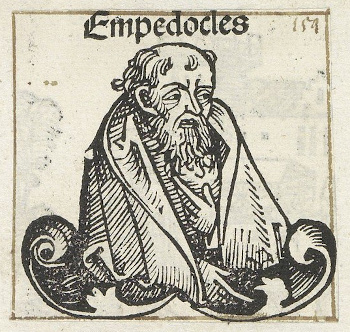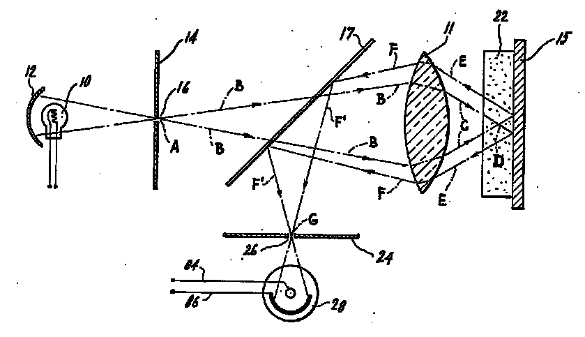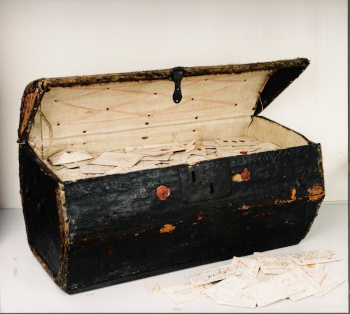X-raying Sealed Letters
April 12, 2021
Superman first appeared in
comics in 1938. While he wasn't the first
superhero character (the
Greek gods might qualify as superheros), he became one of the most
popular, and his
powers and
fanbase increased over the course of many
decades. One evidence of popularity is the appearance of "
spin-off" characters, such as
Superboy,
Supergirl, and
Krypto the Superdog.
One of Superman's powers is his
X-ray vision. While this ability to see through walls, etc., has the commonality with X-rays that it's thwarted by a
lead shield, it's a strange sort of X-ray vision. The vision is more like
terahertz imaging. Unlike conventional
X-ray imaging (radiography) in which the imaging is done through
transmission of the X-rays through objects, Superman
emits X-rays from his
eyes to the same effect (I wonder whether he's a
licensed X-ray emitter).

Empedocles (c.494-434 BC), as depicted in a 1463 engraving by Neurenberg printmakers Michel Wolgemut and Wilhelm Pleydenwurff.
There's a link between Superman's X-ray vision and the visual perception theory of the fifth century BC Greek philosopher, Empedocles.
(Via Wikimedia Commons.)
Strange as it sounds, the idea that vision occurs through
beams emitted by the eyes was common among some
ancient philosophers. This is despite clear evidence, such as the ability to see during the
day, not at
night, and the existence of
shadows, that
sunlight is crucial.
Plato (c.427-347 BC) and
Empedocles (c.494-434 BC) embraced this
theory, as did
Ptolemy (c.100-170), but it might not surprise us that
Euclid (c. 300 BC) did not. In his
Optics (Ὀπτικά), Euclid questioned how we can see the distant
stars immediately after opening our eyes.[1] It appears that Euclid had the idea that the
speed of light was
finite.
Confocal microscopy is another method used by
scientists to image below an object's
surface. This technique,
patented in 1957 by the ever
versatile Marvin Minsky (1927-2016), scans a
focused point of
light below the surface of a
translucent object and detects the
reflected light by a similarly focused
photodetector. A
spatial filter is used to reject light from reflections away from the focused spot. This technique has advanced through the years by the availability of
laser light sources and sensitive
semiconductor photodetectors, such as
avalanche photodiodes, operable at various
wavelengths.

Fig. 3 of US Patent no. 3,013,467, "Microscopy apparatus," by Marvin Minsky, December 19, 1961. (Via Google Patents).
When I was in
high school, I read a
science fiction story about a man who gained a
competitive business advantage by having a device that could copy the fronts and backs of all documents inside closed
attache cases. Now,
technology like this has appeared half a
century later. A recent
open access paper in
Nature Communications describes the X-ray
opening of sealed
letters dating from the
seventeenth century.[3-5] These letters were a portion of about 2600
"locked" letters that were retained since they were undeliverable. Such locked letters were transformed into their own
envelopes by a technique common in the time before the manufacture of envelopes.
This
research was undertaken by a large international team of scientists from the
Massachusetts Institute of Technology (Cambridge, Massachusetts),
Adobe Research (San Francisco, California),
King's College London (London, UK),
Queen Mary University of London (London, UK),
Utrecht University (Utrecht, The Netherlands),
Leiden University (Leiden, The Netherlands), and
Radboud University (Nijmegen, The Netherlands).[3] The research involved a repurposed X-ray scanner used for
microtomography in
dental research and
computational flattening algorithms.[3-5]
Such
software opening of X-ray microtomographically scanned documents has been done before, but only on
scrolls,
books, and documents with one or two
folds.[3] Letterlocked letters have more intricate folds and
tucks, which was a technique to prevent their
undetected reading before being opened by the intended recipient.[3-5] Because of the way these
letterlocked letters were created, such
historical documents could be read only when taken apart.[4] Says study
author,
Jana Dambrogio, of the
Wunsch Conservation Laboratory of the MIT Libraries,
"Letterlocking was an everyday activity for centuries, across cultures, borders, and social classes... It plays an integral role in the history of secrecy systems as the missing link between physical communications security techniques from the ancient world and modern digital cryptography. This research takes us right into the heart of a locked letter."[5]

The Brienne Trunk, a cache of seventeenth century letters created by postmaster and postmistress, Simon and Marie de Brienne.
This collection is now at the Dutch postal museum in The Hague.
(Queen Mary University of London image from the Unlocking History Research Group archive.)
The items of study, called the
Brienne Collection, are the contents of a 17th-century
European postmaster's trunk of 3148
cataloged items with 577 letterpackets that have never been opened.[3-4] The X-ray microtomography scanner, developed at the
laboratories of Queen Mary University of London’s dental research department, has high
sensitivity that enabled it to image the types of
ink in
paper on these letters.[4] This scanner functions like a
medical CT scanner, but it uses much more intense X-rays that allowed detection of
metals in the inks.[4]
The unfolding
algorithm was developed by Amanda Ghassaei and
Holly Jackson of MIT.[5] The
source code is available from
GitHub.[6] The algorithm successfully accomplished unfolding of the letters despite the thinness of the paper, and the very small gap between touching layers.[5] The document initially studied was a July 31, 1697, letter from Jacques Sennacques to his
cousin, Pierre Le Pers, a
French merchant in
The Hague, for a
certified copy of the
death notice of Daniel Le Pers.[5] The algorithm can handle many other types of historical texts, such as books that are too
fragile to open.[5] This research was supported by the
Nederlandse Organisatie voor Wetenschappelijk Onderzoek (Netherlands Organisation for Scientific Research) and other organizations.[3,5]

computer unfolding of letter DB-1538 from the Brienne Collection, a collection that includes 577 letterpackets that have never been opened. (Still images from a Queen Mary University of London video by the Unlocking History Research Group. Click for larger image.[7])
References:
- Harry Edwin Burton, "The Optics of Euclid," J. Opt. Soc. Am., vol. 35 (1945), pp. 357-372 (PDF File from philomatica.org).
- Marvin Minsky, "Microscopy apparatus," US Patent no. 3,013,467, December 19, 1961 (Via Google Patents).
- Jana Dambrogio, Amanda Ghassaei, Daniel Starza Smith, Holly Jackson, Martin L. Demaine, Graham Davis, David Mills, Rebekah Ahrendt, Nadine Akkerman, David van der Linden & Erik D. Demaine, "Unlocking history through automated virtual unfolding of sealed documents imaged by X-ray microtomography," Nature Communications, vol. 12 (March 2, 2021), Article no. 1184. This is an open access article with a PDF file here.
- Secrets of sealed 17th century letters revealed by dental X-ray scanners, Queen Mary University of London Press Release No. 2021SMD, March 2, 2021.
- Researchers virtually open and read sealed historic letters, MIT Libraries Press Release, March 2, 2021.
- Unlocking History virtual-unfolding code by Amanda Ghassaei and Holly Jackson (Github).
- Queen Mary University of London animation of the computer unfolding of letter DB-1538 of the Brienne Collection.
Linked Keywords: Superman; comic; superhero character; Greek mythology; Greek gods; popularity; popular; Superman-powers; fanbase; decade; spin-off (media); Superboy; Supergirl; Krypto the Superdog; X-ray; visual perception; vision; lead shielding; terahertz imaging; X-ray imaging (radiography); transmittance; transmission; spectral line; emission; eye; license; Empedocles (c.494-434 BC); engraving; Neurenberg; printmaking; printmaker; visual perception theory; fifth century BC; Ancient Greek philosophy; Greek philosopher; Wikimedia Commons; emission theory (vision); beams emitted by the eyes; ancient philosopher; day; night; shadow; sunlight; Plato (c.427-347 BC); theory; Ptolemy (c.100-170); Euclid (c. 300 BC); Euclid's Optics (Ὀπτικά); star; speed of light; finite; confocal microscopy; scientist; surface; patent; patented; versatile; Marvin Minsky (1927-2016); focus (optics}; focused; point (geometry); light; translucent; reflection (physics); reflected; photodetector; spatial filter; laser; demiconductor device; avalanche photodiode; wavelength; Google Patents; high school; science fiction; competition; competitive; business; briefcase; attache case; technology; century; open access paper; Nature Communications; letter (message); seventeenth century; letterlocking; "locked" letter; envelope; research; Massachusetts Institute of Technology (Cambridge, Massachusetts); Adobe Research (San Francisco, California); King's College London (London, UK); Queen Mary University of London (London, UK); Utrecht University (Utrecht, The Netherlands); Leiden University (Leiden, The Netherlands); Radboud University (Nijmegen, The Netherlands); microtomography; dentistry; dental; computation; computational; flattening; algorithm; software; scroll; book; book folding; folds; tuck (sewing); tucks; eavesdropping; undetected reading; history; historical; author; Jana Dambrogio; Wunsch Conservation Laboratory of the MIT Libraries; century; centuries; culture; cultures; border; borders; social class; secrecy system; communications security; digital; cryptography; Brienne Trunk; postmaster; postmistress; Dutch postal museum in The Hague; Europe; European; library catalog; cataloged; laboratory; sensitivity (electronics); ink; paper; medical CT scanner; metal; Holly Jackson; source code; GitHub; cousin; France; French; merchant; The Hague; certification; certified; obituary; death notice; brittleness; fragile; Nederlandse Organisatie voor Wetenschappelijk Onderzoek (Netherlands Organisation for Scientific Research); computer; unfold; unfolding.